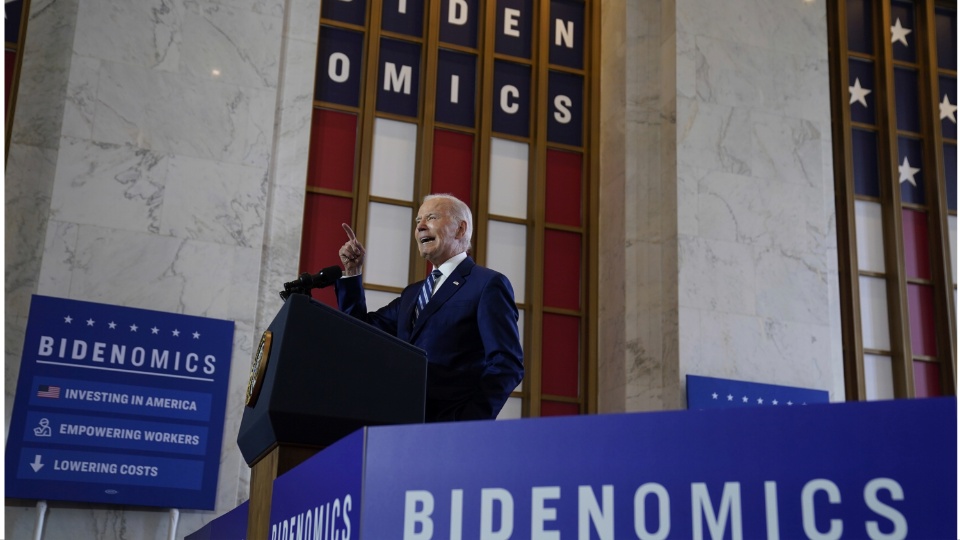
This is the first in a three-part series analyzing the set of policies dubbed “Bidenomics” by the Biden administration and the Democratic Party. In the series, author John Bachtell argues the economic initiatives of the Biden presidency are a break from the neoliberal orthodoxy that’s dominated policymaking in Washington for decades.
“I came to office determined to change the economic direction of this country. To get rid of “trickle-down” economics, which has failed the country for decades,” declared President Joe Biden when speaking at a solar energy manufacturing plant in Columbia, S.C., on July 6. The facility’s construction was funded by the Inflation Reduction Act (IRA), legislation passed without Republican support, including Rep. Joe Wilson, R-S.C., in whose district the event occurred.
Biden’s appearance in South Carolina capped a week of public appearances by administration officials, beginning with his June 28 speech in Chicago outlining the policy framework his supporters have dubbed “Bidenomics,” pitching it as a replacement for “Reaganomics,” or neoliberal economic policies.
As the administration rapidly implements the policies under this framework “across all of government” and society, their enormous sweep is coming into focus: a new theory of economic growth and a set of economic, legislative, and social policies geared to fundamentally break with “trickle-down” policies while instituting a national industrial policy carrying out a green energy transition and addressing massive economic and social inequality.

According to Biden administration officials, the new policies rest on three pillars: modernizing the U.S. physical infrastructure and targeting investments in U.S.-based manufacturing, science, and research and development for a green energy transition interwoven with environmental justice; empowering workers and working-class and historically marginalized communities; and increasing economic competitiveness through anti-trust enforcement and regulatory changes to reduce consumer costs and economic inequality.
The Biden administration policies are “turning out to be the most successful set of economic policies the United States has witnessed in a half-century,” according to former Secretary of Labor Robert Reich. They include the most significant investments in science, research, and development since WWII.
The IRA, American Rescue Plan (ARP), Infrastructure and Investment Jobs Act (IIJA), and CHIPs and Science Act (CHIPS) are infusing $4 trillion in massive public investments into the economy, already catalyzing some 35,000 projects. To date, federal tax credits, loans, and grants have incentivized nearly $500 billion in private capital investments in the green energy sector, surprising economists and the administration.
The policies have spurred the creation of 13 million jobs, including 800,000 in the manufacturing sector alone, the lowest continuous unemployment rate in 50 years, a higher labor participation rate, and an inflation rate that has fallen to 3% from its peak. As a result, economists have lowered the probability of an economic recession in the near term.
Spending from the four bills doesn’t equal the scale of the Green New Deal, the $10 trillion program scientists and environmentalists insist is necessary to decarbonize the economy by 2050. But their passage was a historic victory for pro-democratic, pro-environmental forces and the first step of a green transition.
The bills were a compromise and reflected what Biden, Democrats, and the mass democratic movement could achieve given the political balance of forces: total GOP obstruction, fierce resistance from the fossil fuel industry, and narrow Democratic Congressional majorities.
Instead of creating the “Big Green State” and a transition led by the public sector, the legislation guarantees a private sector-led transition. The legislation also contained painful concessions to the fossil fuel industry, including expedited drilling on public lands, anti-labor forces, and deficit hawks. However, progressives were able to win many vital components and far-sighted programs that can be built upon.
Turning away from failed neoliberalism
In the 1970s, global capitalist elites sought to replace the dominant Keynesian economic and the New Deal political framework with what came to be known as neoliberalism. Unregulated capitalism was the response to the falling rate of corporate profits, insulated against restrictions imposed by democratic governance, the growth of organized labor and expansion of social benefits, and the triumph of anti-colonial revolutions in developing nations, where significant resource extraction occurs.

Neoliberalism entailed top-down economic management, curtailed democratic rights, drastically reduced public investment, removed barriers to capital flow and trade, and greater labor mobility, resulting in the “race to the bottom” embodied in “free trade” agreements/zones such as NAFTA and the EU, as well as in international bodies like the World Trade Organization.
Neoliberalism accelerated the climate crisis by weakening environmental protections and outsourcing jobs and pollution to developing economies without ecological protections.
Its proponents opposed national industrial policies, and neoliberalism proved dismal economically with declining growth rates.
U.S. neoliberalism manifested itself as “Reaganomics”— the fraud that massive tax cuts to corporations and the wealthy would “trickle down” to working-class communities, and everyone would prosper. “We’re still waiting for that,” quipped Biden.
Instead, deep economic and social inequality resulted, including among historically marginalized and people of color communities and in entire regions. Corporate concentration accelerated, and the global wealth gap grew to staggering proportions.
Reaganomics starved public infrastructure and research and development funding, privatized public assets and services, gutted environmental and consumer protections, and cut the social safety net to the bone.
Corporations outsourced millions of manufacturing jobs to low-wage zones in the Global South, often facilitated with government subsidies. The exodus hollowed out domestic manufacturing capacity, and working-class communities were left to pick through the wreckage.
Federal and state governments under right-wing GOP control engaged in union-busting, suppressed wages and benefits, gutted worker safety protections, and slashed taxes on the wealthy and corporations.
A breaking point
Neoliberalism culminated in the 2008-09 global financial crisis. This proved to be a breaking point, and neoliberalism lost its legitimacy as growing numbers of mainstream economists and the public turned against it.
The financial crisis, coming on top of all the other wreckage, fueled working-class insecurity and anger. Right-wing demagogues and the Tea Party movement found fertile ground to spread confusion, racist scapegoating, and misdirected anger. Polarization and political crisis ensued, seen most starkly with the rise of Trump, MAGA, and Brexit on the one hand and the response to the candidacy of democratic socialist Sen. Bernie Sanders, I-Vt, on the other.
Discontent and protest in the U.S. and globally met neoliberalism at every turn. Leading circles of the Democratic Party, exemplified by Biden, economists, and policymakers, also drew their own conclusions. They reacted to the economic carnage, the global financial crisis, and the 2016 elections by gradually abandoning some of neoliberalism’s main premises.
According to Biden’s economic advisors, the economic policies of neoliberalism—though they do not reference the term itself—cannot solve the deep structural and social crises they have created, let alone respond to enormous new domestic and global challenges: the rapidly growing climate and ecological crisis, geopolitical shocks from the global financial meltdown, the global supply chain crisis from the COVID pandemic, the rise of China as a global economic powerhouse, and price shock to global energy markets resulting from the Russian war of aggression against sovereign Ukraine.

Nevertheless, the Biden administration believes the new framework and policies will help build a new majority political coalition and social consensus, much like the New Deal coalition, which dominated politics for 40 years. Such a coalition would include a green power capital sector and constituencies benefiting from green energy construction that would form a counterweight to fossil fuel power.
Such a broad coalition and constituencies in every state and congressional district could lock in transformative policies, including a green transition, empowering workers and working-class and marginalized communities, and addressing wealth and social inequality.
“Bidenomics” and the turn from neoliberalism creates a new terrain of struggle. Suppose Biden, Democrats, and the pro-democracy coalition prevail in the 2024 elections over MAGA austerity, anti-science, climate denialism, and fossil fuel power. The new economic and social framework and policy trajectory can be defended and expanded in that case.
Bigger Democratic Congressional majorities, including more progressives at all levels, can dramatically grow its scale, deepen its reform character, address its weaknesses, strengthen its anti-monopoly, pro-labor, environmental justice, and democratic components, and restore elements discarded in the legislative process like free childcare, child tax credit, and further taxing the rich. And momentum to address the existential climate and ecological crises can be accelerated.
This article reflects the opinions of its author.










